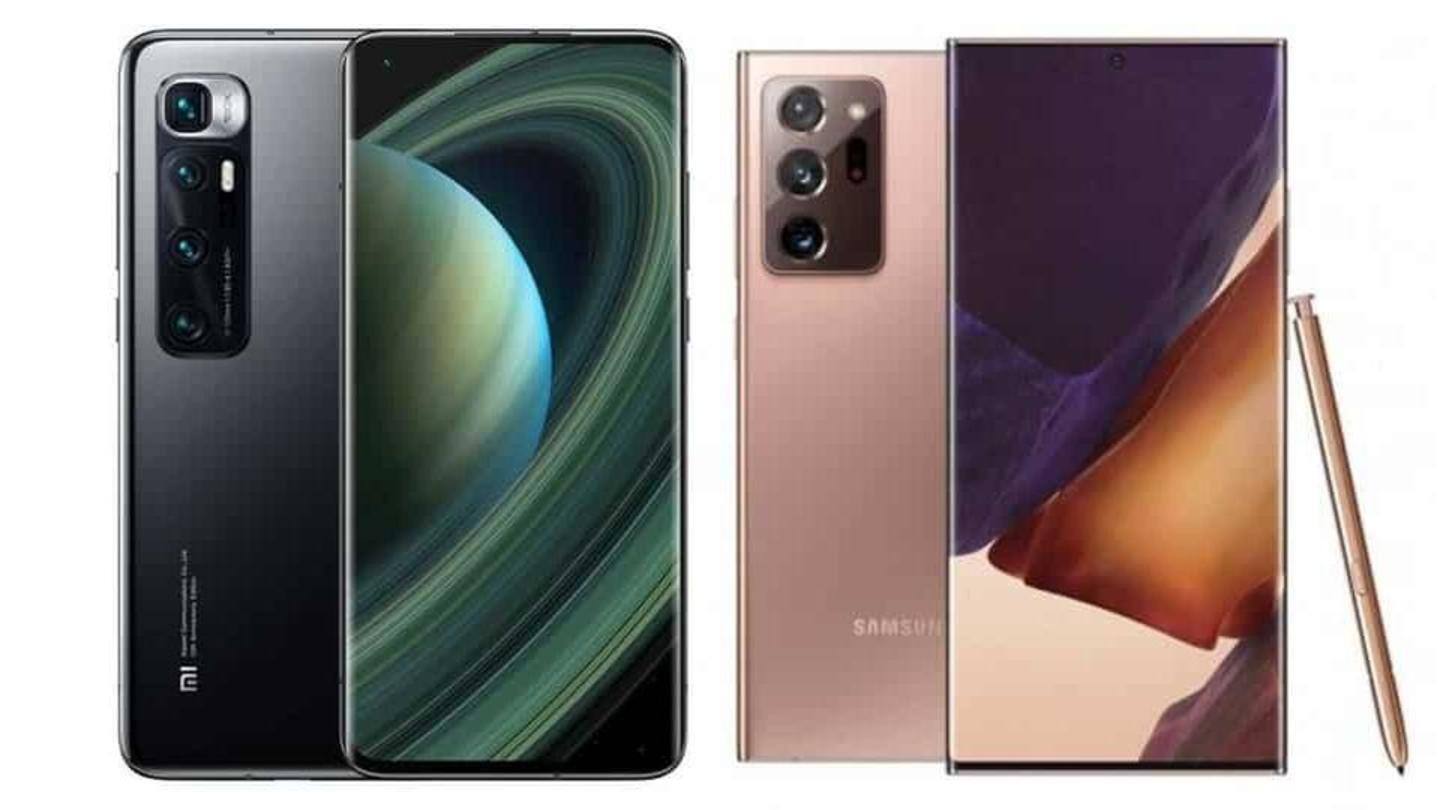
Samsung Note20 Ultra v/s Mi 10 Ultra: Which is better?
What's the story
Rivaling Samsung's zero-compromise flagship offering, the Galaxy Note20 Ultra, Xiaomi has launched the Mi 10 Ultra recently.
Both the handsets aim to justify their "Ultra" monikers by offering top-tier hardware and some industry-leading features like 120W fast-charging on Xiaomi's offering and S Pen support on the Note model for enhanced productivity.
But which one deserves the "Ultra" tag? Let's find out.
Design
Note20 Ultra v/s Mi 10 Ultra: At a glance
Both the Note20 Ultra and Mi 10 Ultra offer a bezel-less look with curved screen edges, a punch-hole design, and a premium metal-glass construction.
However, the Note model has two clear advantages: IP68-rated dust and water-resistance and Gorilla Glass Victus protection, the toughest glass ever on a smartphone. In comparison, Xiaomi's handset has no official water-proofing.
Winner: Note20 Ultra.
Display
All about the screen
Samsung's Note20 Ultra features a massive 6.9-inch WQHD (1440x3200 pixels) AMOLED display, which delivers 1,500 nits of brightness - the highest on any smartphone. The screen is also capable of refreshing at 120Hz, making scrolling and animations feel buttery smooth.
The Mi 10 Ultra settles for a 120Hz 6.67-inch Full-HD+ (1080x2340 pixels) OLED screen with a peak brightness of 1,120 nits.
Winner: Note20 Ultra.
Primary camera
For the shutterbugs
The Note20 Ultra offers a triple-lens primary shooter, which includes a 108MP primary sensor, a 12MP ultra-wide-angle camera, and a 12MP telephoto lens with 50x hybrid zoom.
The Mi 10 Ultra sports a quad rear camera setup, comprising a 48MP main sensor, a 20MP ultra-wide lens, a 12MP portrait camera, and a 48MP telephoto camera with 120x hybrid zoom.
Winner: Mi 10 Ultra.
Information
For the selfie lovers
On the front, the Note20 Ultra offers a 10MP (f/2.2) camera for clicking selfies and video calling. In comparison, the Mi 10 Ultra has a 20MP (f/2.3) front-facing camera. Winner: Mi 10 Ultra for its higher megapixel sensor.
Internals
Under the hood
The Note20 Ultra is powered by the Snapdragon 865+/Exynos 990 chipset, combined with up to 12GB of RAM and up to 512GB of storage.
In contrast, the Mi 10 Ultra is backed by a Snapdragon 865 chipset, paired with up to 16GB of RAM and up to 512GB of storage.
Winner: Note20 Ultra for packing the latest flagship processor.
Information
Thanks to S Pen, Note20 Ultra offers better productivity
The Note20 Ultra comes with an improved S Pen (9ms latency) that lets you write on the screen, edit text, mark up photos, and click pictures. The handset also supports Wireless DeX mode and offers greater compatibility with your Windows 10 PC or laptop.
Nitty-gritty
Battery to biometrics
Under the hood, both models pack a 4,500mAh battery.
However, the Note20 Ultra supports 25W wired charging and 15W wireless charging, whereas Mi 10 Ultra offers unprecedented 120W wired charging and 50W wireless charging.
Both the handsets also come with stereo speakers, in-screen fingerprint sensors, Wi-Fi 6 support, and 5G compatibility.
Winner: Mi 10 Ultra for its industry-leading charging technology.
Information
Pricing: The key factor
The Mi 10 Ultra starts at CNY 5,299 (Rs. 57,000) for the entry-level 8GB/128GB variant and goes up to CNY 6,999 (Rs. 75,200) for the range-topping 16GB/512GB variant. On the other hand, the Note20 Ultra (12GB/256GB) carries a price tag of Rs. 1,04,999 in India.
Our verdict
How things stack up?
The Mi 10 Ultra offers the best camera performance on any smartphone and superfast charging speeds but misses out on a high-resolution screen, water resistance, and the latest chipset.
In comparison, the Note20 Ultra justifies its moniker by offering a premium and durable build quality, excellent screen, high-end versatile cameras, and top-spec hardware with added productivity features.
Our "Ultra" pick is the Note20 Ultra.